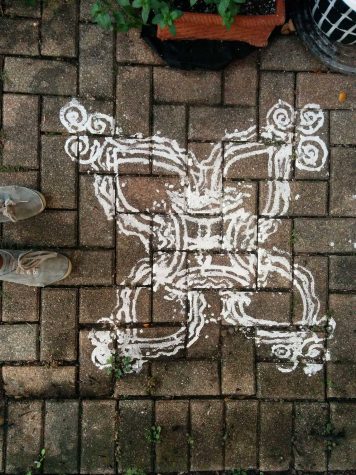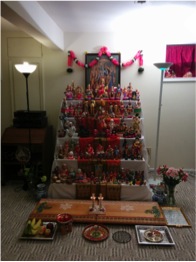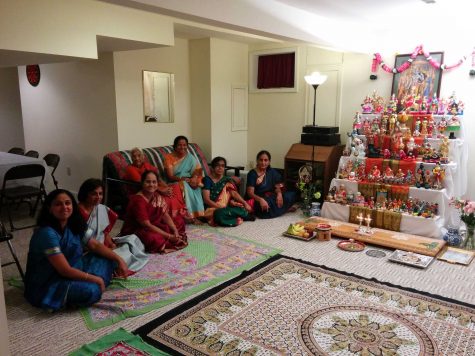Navratri Golu comes to a close
October 13, 2014
The decorated dolls and colorful saris are being put away as the Indian festival Navratri Golu starts to wrap up.
Navratri Golu is a nine-day Indian festival that celebrates the goddess Durga, who symbolizes purity and power. It takes place around Sept./Oct., and it changes every year according to the Indian lunar calendar.
“Nav” means nine and “ratri” means night, forming the word Navratri, the celebration of nine nights.
People perform puja in temples that represent different deities, such as Lakshmi, Saraswati and Durga, the goddesses of wealth, knowledge and power respectively.

This is an example of puja in front of a house for Navratri Golu. Puja is a symbol of welcome and celebration at an entrance of a home. The design is made with rice flour paste.
Typically these festivals are celebrated across the country and each region has its own unique set of traditions related to the festival.
Different parts of India celebrate Navratri in different ways. For example, in the state of Gujarat in west India there is a special dance performed with slim wooden sticks, in honor of Lord Krishna.
In south India, during Navratri, different idols of gods are arranged on steps and guests are invited to participate in the puja as well as to eat special foods with family and friends.
“I like this festival because it is creative, and I really like setting up the dolls,” freshman Lavanya Konda said.

Shown here is an example of how dolls are exhibited. Displayed here is 30 years worth of doll collecting. Some of these dolls are almost 100 years old.
Navratri is a mixture of both cultural and religious celebrations of the victory of good over evil.
“Personally, I celebrate [Navratri] because my origin is from India, and Navratri is a part of the culture there,” Mrs. Usha Raghavan said. “It is a tradition, and a religious ceremony as well.”

Women and girls traditionally sit on the floor, facing the dolls. People can come up and sing traditional Indian songs. The family and friends attending also wear traditional clothing.
Even if an individual is not religious, it is an opportunity to get together with friends and family, as well as an occasion to dress up.
“People come and sing and you can display your talents in that way,” Raghavan said. “Or you can show your creativity through art.”
In Japan, there is a similar festival celebrated on March 3 called Hinamatsuri, or “Girls Day.”
It also is referred to as “Peach Day” and people pray for young girls’ growth and happiness during this time.
This festival has similar aspects to Navratri, such as the doll display. In Japan, there is usually a five to seven step stand covered in a red cloth, where the dolls are displayed.
For the five-layered stands, the topmost one usually has two dolls representing the emperor and empress. The second one has three court ladies, third has five musicians, fourth, two ministers, and the bottommost step has three servants or samurai.
Both Navratri and Hinamatsuri are celebrations specifically for girls.
“I don’t celebrate it obviously because I’m a boy. All I do is eat food,” freshman Hajime Minoguchi said, “But it’s a good tradition that Japan has.”






